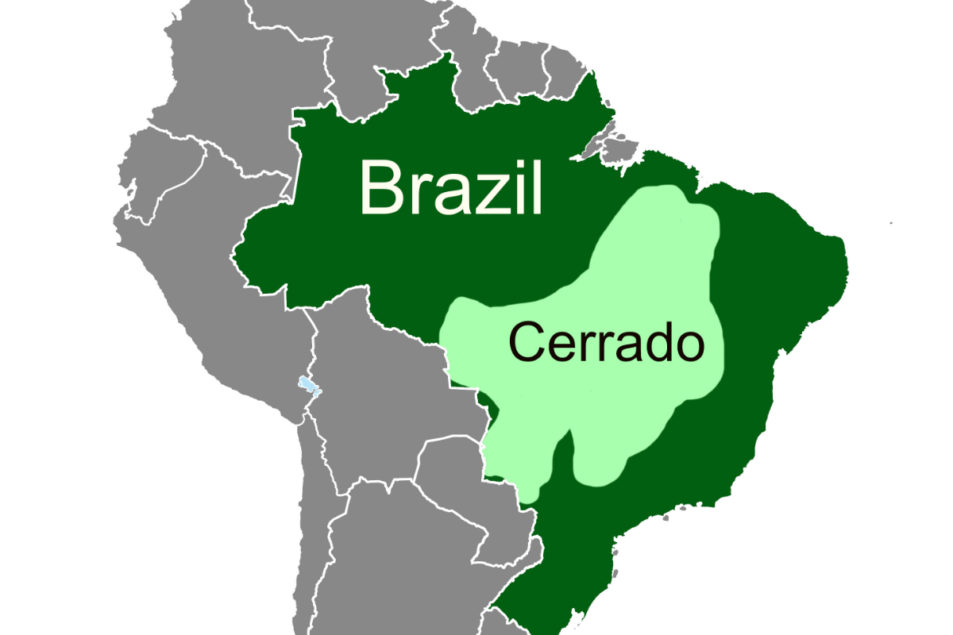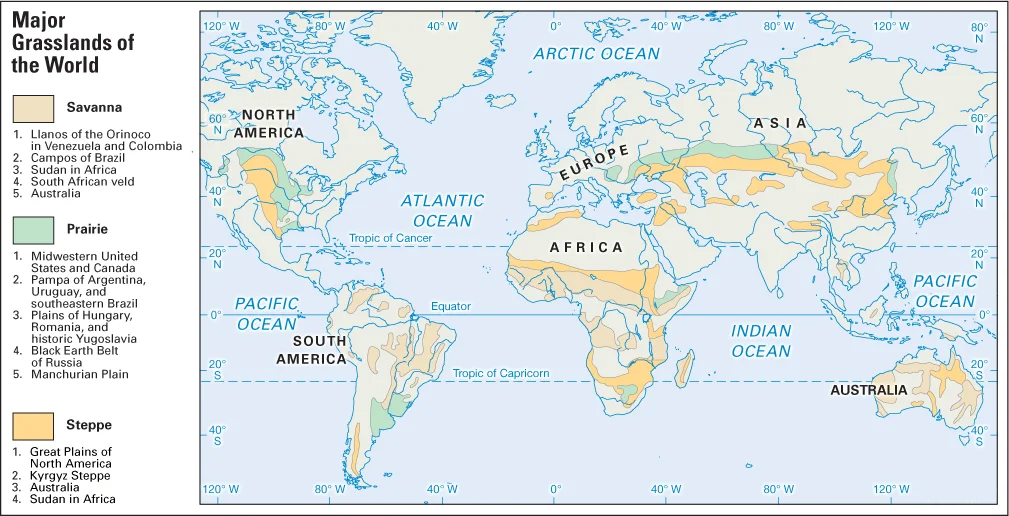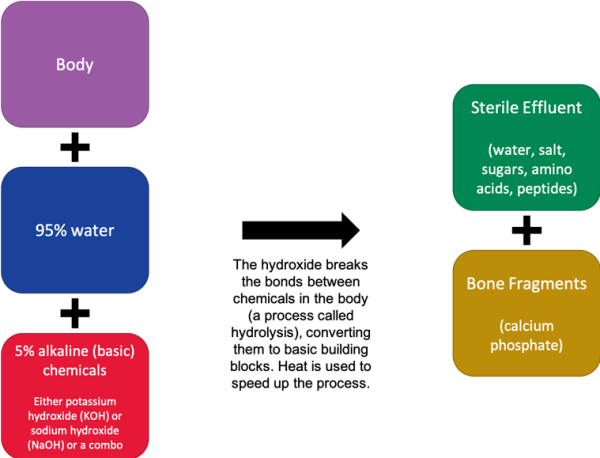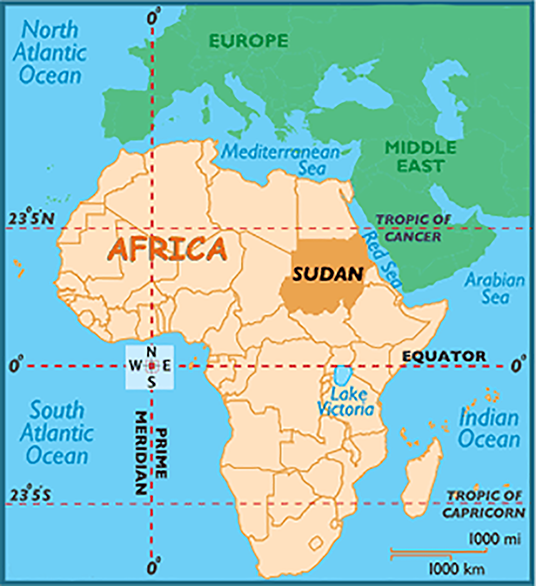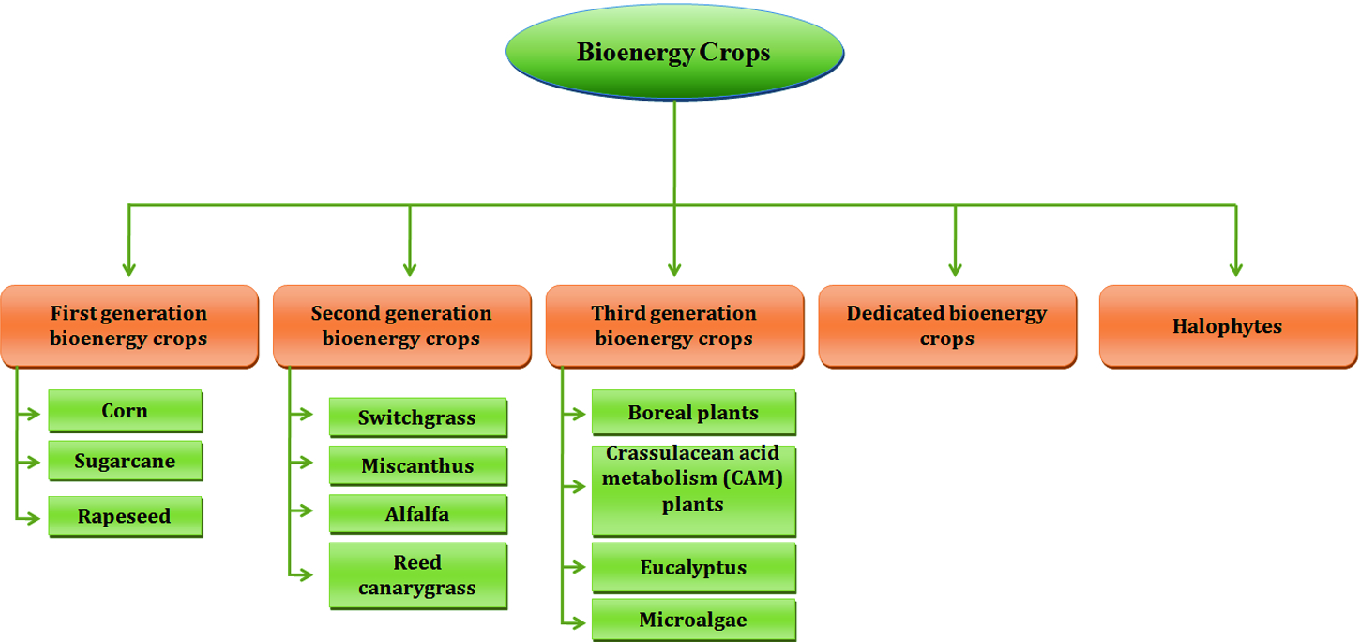Geography
Deforestation in Cerrado: Brazil
For Prelims: Deforestation, its causes and effects, Savanna, location of various grasslands.
For mains: Deforestation, its causes and effects, Savanna, its distribution and environment.
Why in News
Deforestation in 2021 rose to the highest level since 2015 in Brazil’s Cerrado, prompting scientists to raise alarm over the state of the world’s most species-rich savanna.
- Earlier, it was also found that the area deforested in Brazil's Amazon reached a 15-year high after a 22% jump from the prior year (2020).
Key Points
- About:
- The Cerrado is spread across several states of Brazil and is one of the world’s largest savannas, is often called an “upside-down forest” because of the deep roots its plants sink into the ground to survive seasonal droughts and fires.
- Cerrado is a major carbon sink that helps to stave off climate change.
- Destruction of Cerrado:
- Destruction of these trees, grasses and other plants in the Cerrado is a major source of Brazil’s greenhouse gas emissions, although it is far less densely forested than the more famous Amazon rainforest that it borders.
- Deforestation and other clearances of native vegetation in the Cerrado rose 8% to 8,531 square kilometers in the 12 months through July 2021.
- Scientists blame the government for encouraging deforestation with his pro-development rhetoric and for rolling back environmental enforcement.
- Destruction of these trees, grasses and other plants in the Cerrado is a major source of Brazil’s greenhouse gas emissions, although it is far less densely forested than the more famous Amazon rainforest that it borders.
Deforestation
- About:
- Deforestation is the permanent removal of trees to make room for something besides forest. This can include clearing the land for agriculture or grazing, or using the timber for fuel, construction or manufacturing.
- Today, most deforestation is happening in the tropics. Areas that were inaccessible in the past are now within reach as new roads are constructed through the dense forests.
- A 2017 report by scientists at the University of Maryland showed that the tropics lost about 1,58,000 square kilometers of forest in 2017 — an area the size of Bangladesh.
- Effect:
- Deforestation in tropical regions can also affect the way water vapor is produced over the canopy, which causes reduced rainfall.
- Deforestation not only removes vegetation that is important for removing carbon dioxide from the air, but the act of clearing the forests also produces greenhouse gas emissions.
- It is also causing loss of biodiversity and animal life.
Savanna
- About:
- Savanna, also spelled savannah, vegetation type that grows under hot, seasonally dry climatic conditions and is characterized by an open tree canopy (i.e., scattered trees) above a continuous tall grass understory (the vegetation layer between the forest canopy and the ground).
- The largest areas of savanna are found in Africa, South America, Australia, India, the Myanmar (Burma)–Thailand region in Asia, and Madagascar.
- Environment of Savannas:
- In general, savannas grow in tropical regions 8° to 20° latitudes from the Equator.
- Conditions are warm to hot in all seasons, but significant rainfall occurs for only a few months each year—about October to March in the Southern Hemisphere and April to September in the Northern Hemisphere.
- Mean annual precipitation is generally 80 to 150 cm although in some central continental locations it may be as low as 50 cm .
- The dry season is typically longer than the wet season, but it varies considerably, from 2 to 11 months. Mean monthly temperatures are about 10 to 20 °C in the dry season and 20 to 30 °C in the wet season.
- Sub-Divisions of Savannas:
- Savannas may be subdivided into three categories—wet, dry, and thornbush—depending on the length of the dry season. In wet savannas the dry season typically lasts 3 to 5 months, in dry savannas 5 to 7 months, and in thornbush savannas it is even longer.
- An alternative subdivision recognizes savanna woodland, with trees and shrubs forming a light canopy, tree savanna, with scattered trees and shrubs, shrub savanna, with scattered shrubs; and grass savanna, from which trees and shrubs are generally absent.
- In spite of their differences, all savannas share a number of distinguishing structural and functional characteristics.
- Generally, they are defined as tropical or subtropical vegetation types that have a continuous grass cover occasionally interrupted by trees and shrubs and that are found in areas where bushfires occur and where main growth patterns are closely associated with alternating wet and dry seasons.
- Savannas can be considered geographic and environmental transition zones between the rainforests of equatorial regions and the deserts of the higher northern and southern latitudes.
- Vegetation:
- Grasses and trees that grow in the savanna have adapted to life with little water and hot temperatures.
- Grasses, for example, grow quickly in the wet season when water is abundant and turn brown in the dry season to conserve water.
- Some trees store water in their roots and only produce leaves during the wet season.
- Due to frequent fires, grasses are short and close to the ground and some plants are fire resistant. Examples of vegetation in the savanna include wild grasses, shrubs, baobab trees, and acacia trees.
- Fauna:
- It is home to many large land mammals, including elephants, giraffes, zebras, rhinoceroses etc. Other animals include baboons, crocodiles, antelopes etc.
- Many of the savanna biome animals are grazing herbivores that migrate through the region.


Indian Polity
Right to Privacy
For Prelims: K.S. Puttaswamy case, Article 21, Various dimensions of Right to privacy.
For Mains: K.S. Puttaswamy case, Right to privacy, Article 21, the Personal Data Protection Bill 2019.
Why in News
Recently, a Judge of the Madras High Court has said that a recent order passed by another judge of the same court, mandating the installation of CCTV cameras inside spas [massage and therapy centres], appears to run counter to the Supreme Court's landmark judgement in K.S. Puttaswamy case (2017).
- In this case, the Supreme Court declared that the right to life and personal liberty guaranteed in Article 21 also implicitly includes a right to privacy.
Key Points
- About:
- Underlying Values: This right to privacy is seen as possessing:
- Inherent value: It is important for every person’s basic dignity.
- Instrumental value: It furthers a person’s ability to live life free of interference.
- Forms of Right to Privacy: The privacy as guaranteed in Article 21 takes several different forms. It includes:
- A right to bodily autonomy,
- A right to informational privacy,
- A right to a privacy of choice.
- Right to Relax: Suspicion that immoral activities are taking place in spas cannot be a reason enough to intrude into an individual’s right to relax, for it intrinsically is part and parcel of his fundamental right to privacy.
- Thus, the installation of CCTV equipment inside premises such as a spa would unquestionably go against a person’s bodily autonomy.
- These are inviolable spaces where the prying eye of the State cannot be allowed to enter.
- Doctrine of Separation of Powers: The reach of the fundamental rights cannot be curtailed by any judicial measure.
- It held that, though no right can be absolute, restrictions can be put in place only by the legislature or the executive.
- Apart from it, the Supreme Court alone can do so in exercise of its power under Article 142.
- Underlying Values: This right to privacy is seen as possessing:
Right to Privacy
- About:
- Generally understood that privacy is synonymous with the right to be let alone.
- The Supreme Court described privacy and its importance in the landmark decision of K.S. Puttaswamy v. Union of India in 2017.
- The right to privacy is protected as an intrinsic part of the right to life and personal liberty under Article 21 and as a part of the freedoms guaranteed by Part III of the Constitution.
- The Puttaswamy judgement holds that the right to privacy is protected as a fundamental constitutional right under Articles 14, 19 and 21 of the Constitution of India.
- Restrictions (as stated in the Judgement):
- The right may be restricted only by state action that passes each of the three tests:
- First, such state action must have a legislative mandate.
- Second, it must be pursuing a legitimate state purpose, and
- Third, it must be proportionate i.e., such state action- both in its nature and extent, must be necessary in a democratic society and the action ought to be the least intrusive of the available alternatives to accomplish the ends.
- The right may be restricted only by state action that passes each of the three tests:
- Step taken by Government: Acknowledging the importance of privacy, the Government has presented the personal Data Protection Bill 2019 in the Parliament.


Governance
State of India’s Dams
For Prelims: Gandhi Sagar Dam, Chambal River, provisions of the Dam Safety Bill, 2019
For Mains: concerns regarding the ageing dams of India and related steps that can can be taken
Why in News
According to a new Comptroller and Auditor General of India (CAG) report, Gandhi Sagar Dam on Chambal River (Madhya Pradesh) is in need of immediate repair.
- Absence of regular checks, non-functional instruments and choked drains are the major problems plaguing the dam for years.
Gandhi Sagar Dam
- It is one of the five water reservoirs of national importance.
- Gandhi Sagar Dam was constructed in 1960 to provide drinking water to several districts of Rajasthan and generate 115 megawatts of electricity.
- It has been breached several times in recent years, causing flooding in downstream areas.
Key Points
- About:
- India is ranked third in the world in terms of building large dams.
- Of the over 5,200 large dams built so far, about 1,100 large dams have already reached 50 years of age and some are older than 120 years.
- The number of such dams will increase to 4,400 by 2050.
- This means that 80% of the nation’s large dams face the prospect of becoming obsolete as they will be 50 years to over 150 years old.
- The situation with hundreds of thousands of medium and minor dams is even more dangerous as their shelf life is even lower than that of large dams.
- Examples: Krishna Raja Sagar dam was built in 1931 and is now 90 years old. Similarly, Mettur dam was constructed in 1934 and is now 87 years old. Both these reservoirs are located in the water scarce Cauvery river basin.
- Issues with India’s Aging Dam:
- Built according to the Rainfall Pattern:
- Indian dams are very old and built according to the rainfall pattern of the past decades. Erratic rainfall in recent years has left them vulnerable.
- But the government is equipping the dams with information systems like rainfall alerts, flood alerts, and preparing emergency action plans to avoid all sorts of mishaps.
- Decreasing Storage Capacity:
- As dams age, soil replaces the water in the reservoirs. Therefore, the storage capacity cannot be claimed to be the same as it was in the 1900s and 1950s.
- The storage space in Indian reservoirs is receding at a rate faster than anticipated.
- Flawed Design:
- Studies show that the design of many of India’s reservoirs is flawed.
- Indian reservoirs are designed with a poor understanding of sedimentation science.
- The designs underestimate the rate of siltation and overestimate live storage capacity created.
- High Siltation Rates:
- It refers both to the increased concentration of suspended sediments and to the increased accumulation (temporary or permanent) of fine sediments on bottoms where they are undesirable.
- Built according to the Rainfall Pattern:
- Consequences:
- Impacting Food Security: When soil replaces the water in reservoirs, supply gets choked. In this case, the cropped area may begin receiving less and less water as time progresses.
- As a result, the net sown water area either shrink in size or depends on rains or groundwater, which is over-exploited.
- Impacting Farmers’ Income: As crop yield may get affected severely, it would disrupt the farmer’s income.
- Moreover, water is a crucial factor for crop yield and credit, crop insurance, and investment.
- Increased Flooding: The flawed siltation rates reinforce the argument that the designed flood cushion within several reservoirs across many river basins may have already depleted substantially, due to which floods have become more frequent downstream of dams.
- Impacting Food Security: When soil replaces the water in reservoirs, supply gets choked. In this case, the cropped area may begin receiving less and less water as time progresses.
- Need of the Dam Safety:
- To Safeguards People Lives:
- Ageing dams can serve as a cause of concern for people living in the areas nearby.
- Safeguarding Investment:
- Safety of dams is also important for safeguarding the huge public investment in this critical physical infrastructure, as also, for ensuring continuity of benefits derived from the dam projects and national water security.
- Tackle India’s water crisis:
- Safety of dams is also important in the emerging scenario of India’s water crisis, linked with its growing population, as also the climate change.
- To Safeguards People Lives:
- Related Initiatives:
- Dam Safety Bill, 2019: Rajya Sabha has recently passed the Dam Safety Bill, 2019.
- The bill provides for surveillance, inspection, operation and maintenance of the specified dam, for prevention of dam failure related disaster, and also makes provision for institutional mechanisms to ensure their safe functioning.
- Dam Rehabilitation and Improvement Project (DRIP Phase II): To improve the safety and performance of selected existing dams and associated appurtenances in a sustainable manner.
- Dam Safety Bill, 2019: Rajya Sabha has recently passed the Dam Safety Bill, 2019.
Way Forward
- The most important aspect in ensuring dam safety is the existence of accountability and transparency while taking into consideration the views of the real stakeholders--the people living downstream from the dams, who are the most at-risk group in case of a breach.
- In terms of the operational safety, the rule curve, that decides how a dam is supposed to be operated and is created when a dam is proposed, needs to be upgraded at regular intervals on the basis of environmental changes such as siltation and rainfall pattern since these would change the frequency and intensity of incoming flood into the dam as well as the spillway capacity.
- The rule curve also needs to be in the public domain so that the people can keep a check on its correct functioning and can raise questions in its absence.
- Moreover, in India every river has multiple dams along its course, so a cumulative assessment of every upstream and downstream dam needs to be in place to ensure dam safety in terms of operations.
Biodiversity & Environment
Aquamation
For Prelims: Aquamation, Nobel Peace Prize, greenhouse gases, Desmond Tutu water cremation, green cremation, flameless cremation, chemical cremation.
For Mains: Noble prize, Apartheid
Why in News
Recently, the Nobel Peace Prize winner Anglican archbishop and anti-apartheid campaigner Desmond Tutu died. He was very passionate about protecting the environment and taking necessary actions.
- In concurrence of his passion to save the environment, his body underwent aquamation, a green alternative to traditional cremation methods.
- The process of aquamation uses energy which is five times less than fire. It also reduces by about 35% the amount of greenhouse gases that are emitted during cremation.
Key Points
- About Aquamation:
- It is a process in which the body of the deceased is immersed for a few hours in a mixture of water and a strong alkali in a pressurized metal cylinder and heated to around 150 degree centigrade.
- The combination of gentle water flow, temperature and alkalinity accentuate the breakdown of the organic materials.
- The process leaves behind bone fragments and a neutral liquid called effluent.
- The effluent is sterile, and contains salts, sugars, amino acids and peptides.
- There is no tissue and no DNA left after the process completes.
- Background: The process was developed and patented in 1888 by Amos Herbert Hanson, a farmer who was trying to develop an ingenious way to make fertilizer from animal carcasses.
- The first commercial system was installed at Albany Medical College in 1993.
- Thereafter, the process continued to be in use by hospitals and universities with donated body programmes.
- This process is referred to as alkaline hydrolysis or as Cremation Association of North America (CANA) (an international non-profit organisation) calls it flameless cremation.
- The process is also known as water cremation, green cremation or chemical cremation.
Desmond Tutu
- Desmond Tutu is one of South Africa’s most well-known human rights activists, winning the 1984 Nobel Peace Prize for his efforts in resolving and ending apartheid.
- He is known as the voice of the voiceless for Black South Africans.
- When Nelson Mandela was elected as the nation’s first Black president—he appointed Tutu chairperson of the Truth & Reconciliation Commission.
- The Truth and Reconciliation Commission was a court-like restorative justice body assembled in South Africa in 1996 after the end of apartheid.
- As the chairman, Desmond Tutu has formulated his objective as “a democratic and just society without racial divisions”, and has set forward the following points as minimum demands:
- Equal civil rights for all
- The abolition of South Africa’s passport laws
- A Common system of education
- The cessation of forced deportation from South Africa to the so-called “homelands”.


International Relations
Crisis in Sudan
For Prelims: Location of Sudan and its neighbours.
For Mains: Crisis in Sudan, reasons for it and way forward, History of upheavals in Sudan.
Why in News
Recently, Sudan’s civilian Prime Minister Abdalla Hamdok resigned, plunging the country into further turmoil.
- Mr. Hamdok, who was sacked by the military in October 2021 and reinstated a few weeks later as part of a deal, stepped down as anti-military protests continued to rock the country.
- Sudanese pro-democracy groups rejected Mr. Hamdok’s deal with the military and demanded the Generals hand over power to an independent civilian authority.
Key Points
- Unstable Sudan:
- Sudan is at a familiar deadlock, subject to the whims of a brutal military regime after a coup. On a continent with a bad record in this respect, Sudan is in a class of its own, with six coups and 10 failed attempts since independence in 1956.
- Since independence Sudan has been governed, with only occasional breaks, by an Arab elite in Sudan, bent on plundering the country’s considerable wealth at the expense of its people.
- Their rule, exercised through the army, has been cloaked in the language of Islam; it is really a kleptocracy.
- Kleptocracy is a government whose corrupt leaders use political power to appropriate the wealth of their nation, typically by embezzlement or misappropriation of government funds at the expense of the wider population.
- The consequence is a country beset by wars and conflict between the centre and the immiserated peripheries. The army and its allied militias, notably the Rapid Support Forces, have used their power to carve out swathes of the economy for themselves, well beyond defence industries.
- Civilian rule, bringing transparency, as well as democracy, would threaten those financial interests.
- The victims of decades of misrule are ordinary Sudanese. Facing inflation rates of over 100%, almost a quarter of the population can barely feed themselves and millions live in refugee camps.
- By contrast, the elites seem to get by. Therefore the elites will fight to preserve the status quo.
- Current Crisis:
- The churn has accelerated since General Omar al-Bashir, indicted for genocide, was toppled by a popular revolution in April 2019.
- Subsequently, the Sovereignty Council, an 11-member body comprising military and civilian leaders that replaced the military-led transition council, appointed Mr. Hamdok as Prime Minister.
- During the Sovereignty Council’s rule, Sudan entered into a peace deal with rebel groups, banned female genital mutilation, made peace with Israel and reached out to international powers for economic assistance.
- During this period, the U. took the country off the list of state sponsors of terrorism. Reforms at home and international recognition suggested that Sudan was on a slow but steady transition into full democracy.
- The army struck back almost immediately, killing scores of people. An uneasy alliance of generals and technocrats, headed by Mr Hamdok, governed from August 2019 up to the coup October 2021.
- That so-called transitional government was supposed to pave the way to elections. They now look further off than ever.
- Since the recent coup (2021) the protestors have been protesting against the coup and for a democratic government.
- Russia and China Angle:
- Russia’s Supplies:
- An added complication is Russia’s support for the generals. Wagner, a mercenary outfit acting in the interests of Russia, has supplied training for militias and other goodies.
- Russia has also shielded Sudan at the United Nations(UN), playing its usual spoiler role against the West.
- China’s Investments:
- China’s extensive investments in Sudan have also afforded army protection; China favours stability over good governance.
- Russia’s Supplies:
Way Forward
- The military is now in a difficult position. Given that the civil-military relationship is already at a breaking point.
- The UN estimates that at least a third of the country’s 43 million people will need humanitarian assistance in 2022. What Sudan wants is a stable, responsive government that can urgently address the myriad problems the country faces.
- Ultimately, the price of a successful transition to democracy, which will have to include structural economic reforms, will likely entail some distasteful compromises on issues such as accountability and retention of Bashir-era assets.
- There should be a meaningful dialogue” between all Sudanese parties to “reach an inclusive, peaceful and lasting solution.
- But a genuine transition should also prevent the military from continuing to act as the country’s ultimate authority, able to reset timetables and remove governing officials at will.


Biodiversity & Environment
Bioenergy Crops Create Cooling Effect on Cultivated Areas
For Prelims: Bioenergy Crops, Biofuels.
For Mains: Bioenergy crops and their impact on climate change.
Why in News
A new study has found that converting annual crops to perennial bioenergy crops can induce a cooling effect on the areas where they are cultivated.
- The researchers simulated the biophysical climate impact of a range of future bioenergy crop cultivation scenarios. Eucalyptus, poplar, willow, miscanthus and switchgrass were the bioenergy crops used in the study.
- The study also demonstrated the importance of the crop type choice, the original land use type upon which bioenergy crops are expanded, the total cultivation area and its spatial distribution patterns.
Bioenergy Crops
- Crops from which Biofuels are produced or manufactured are called Biofuel crops or Bioenergy Crops. “Energy crops" is a term used to describe biofuel crops.
- Wheat, corn, main edible oilseeds/edible oils, sugarcane, and other crops are among them.
- Biofuels have a number of advantages over fossil fuels, including the ability to burn cleaner and emit fewer pollutants and greenhouse gases, such as carbon dioxide, into the sky. They're also environmentally friendly, and energy corporations frequently mix Biofuels with gasoline.
Key Points
- −0.08 ~ +0.05 Global Net Energy Change:
- Cultivation area under bioenergy crops occupies 3.8% ± 0.5% of the global total land area, but they exert strong regional biophysical effects, leading to a global net change in air temperature of −0.08 ~ +0.05 degrees Celsius.
- Global air temperature will decrease by 0.03~0.08 °C, with strong regional contrasts and inter-annual variability, after 50 years of large-scale bioenergy crop cultivation.
- Can Impact Carbon Capture and Storage:
- Large-scale bioenergy crop cultivation with carbon capture and storage (BECCS) has been identified as a major negative emission technology (NET) for removing CO2 from the atmosphere.
- Large Spatial Variations:
- Large-scale bioenergy crop cultivation induces a biophysical cooling effect at the global scale, but the air temperature change has strong spatial variations and inter-annual variability.
- Temperature changes in the bioenergy crop scenarios may have very large spatial variations and important climate teleconnections to other areas of the globe.
- Protect Permafrost from Thawing:
- Strong cooling effects in Eurasia, between 60°N and 80°N, may protect permafrost from thawing or reduce methane emissions from wetlands.
- Permafrost is any ground that remains completely frozen—32°F (0°C) or colder—for at least two years straight.
- Eucalypt is Superior to Switchgrass:
- Cultivating eucalypt shows generally cooling effects that are more robust than if switchgrass is used as the main bioenergy crop, implying that eucalypt is superior to switchgrass in cooling the lands biophysically.
- Cooling effects are more for eucalypt and the greatest warming effects are seen for switchgrass.
- Replacing forests with switchgrass not only results in biophysical warming effects but could also release more carbon through deforestation than converting other short vegetation to bioenergy crops.


Important Facts For Prelims
Maharaja Bir Bikram Airport: Tripura
Why in News
Recently, the Prime Minister inaugurated the New Integrated Terminal Building of Maharaja Bir Bikram (MBB) Airport and launched key initiatives like Mukhyamantri Tripura Gram Samridhi Yojana and Project Mission 100 of Vidyajyoti Schools.
Key Points
- About:
- The inauguration of the new terminal is seen as a first step to make the airport operational as an international airport owing to the State’s proximity to Bangladesh and accessibility to southeast Asian countries.

- Local tribal stone sculptures of the Unakoti Hills and local bamboo handicrafts have been extensively used in the interiors.
- The Maharaja Bir Bikram Airport was originally built by the US Air Force during the Second World War (1939-45) in collaboration with King Bir Bikram Kishore Manikya Debbarman of the erstwhile princely State.
- It was formerly known as the Agartala Airport and was renamed in 2018.
- The inauguration of the new terminal is seen as a first step to make the airport operational as an international airport owing to the State’s proximity to Bangladesh and accessibility to southeast Asian countries.
- Bir Bikram Kishore Debbarman:
- Maharaja Colonel Bir Bikram Kishore Manikya Debbarman Bahadur (1908–1947) of the Manikya dynasty is widely regarded as Tripura’s pioneer King.
- He succeeded his father, Birendra Kishore Manikya Debbarman in August 1923. He was succeeded by his own son, Maharaja Kirit Bikram Kishore, who was king for two years till the state’s accession to India in 1949, but who did not rule, as he was a minor.
- He was the king of Tripura State till 1947.
- He played an important role in the development of Tripura. He is known as Father of modern architecture in Tripura: During his rule the entire planning of present-day Tripura was initiated.
- He was a pioneer in land reforms. In 1939, he reserved land for the local Tripura tribals. Later, this step was instrumental in the creation of the Tripura autonomous district council.
- He built the first airport in Tripura (Agartala airport).
- Maharaja Colonel Bir Bikram Kishore Manikya Debbarman Bahadur (1908–1947) of the Manikya dynasty is widely regarded as Tripura’s pioneer King.
- Mukhyamantri Tripura Gram Samridhi Yojana:
- The scheme will promote tap water for every household, housing, Ayushman coverage, insurance cover, KCC (Kisan Credit Card) and roads leading to enhanced confidence in the rural population.
- Project Mission 100 of Vidyajyoti Schools:
- It is aimed to improve the quality of education in the state by converting 100 existing High / Higher secondary schools to Vidyajyoti Schools with state of art facilities and quality education.
- The project will cover about 1.2 lakh students from Nursery to class XII and will cost around Rs. 500 crores in the next three years.


Important Facts For Prelims
IHU Variant of Covid-19
Why in News
Amid the spread of the Omicron Variant of coronavirus, the discovery of a new strain named ‘IHU (Instituts Hospitalo-Universitaires)’ that emerged in France raises fears across the world.
Key Points
- Discovery:
- Its discovery was announced by researchers from Méditerranée Infection in Marseille, part of France’s Instituts hospitalo-universitaires (IHU, or University Hospital Institutes) - hence the name.
- The first known case of the IHU variant was detected in mid-November 2021 in a man from France who had returned from Cameroon in Africa (the continent where Omicron was also discovered).
- About:
- The variant is a sub-lineage of the B.1.640. It has been classified as B.1.640.2.
- The variant has 46 mutations and 37 deletions in its genetic code, more than Omicron. Many of these affect the spike protein.
- Spreading Rate:
- Till now, only a dozen cases have been reported in France. No other country has detected any new cases of the new variant. It is certainly not as alarming as the spread of Omicron.
- While the large number of significant mutations in this variant has attracted the interest of researchers, and raised concerns among the public, the B.1.640 is not spreading at a rate that is unnerving.
- The World Health Organization (WHO) has not yet deemed this IHU variant a variant of interest, a variant of concern, or even a variant under investigation.
Variant of Interest (VOI)
- A variant with specific genetic markers that have been associated with changes to receptor binding, reduced neutralization by antibodies generated against previous infection or vaccination, reduced efficacy of treatments, potential diagnostic impact, or predicted increase in transmissibility or disease severity.
- There are currently two:
- Mu (B.1.621), which emerged in Colombia in early 2021
- Lambda (C.37), which emerged in Peru in late 2020
- Variant of Concern (VOC)
- A variant for which there is evidence of an increase in transmissibility, more severe disease (e.g., increased hospitalizations or deaths), significant reduction in neutralization by antibodies generated during previous infection or vaccination, reduced effectiveness of treatments or vaccines, or diagnostic detection failures.
- The B.1.1.7 (UK variant), B.1.351 (South Africa Variant), P.1 (Brazil Variant), B.1.427, and B.1.429 variants circulating in the US are classified as VOCs.
- Variant of High Consequence
- A variant of high consequence has clear evidence that prevention measures or medical countermeasures have significantly reduced effectiveness relative to previously circulating variants.
- Variants Under Investigation (VUI)
- Public Health England (PHE) says that if the variants of SARS-CoV-2 are considered to have epidemiological, immunological or pathogenic properties, they are raised for formal investigation.
- At this point, the variants emerging from the B.1.617 lineage are designated as VUI.
Mutation, Variant and Strain
- When a virus replicates it doesn’t always manage to produce an exact copy of itself.
- This means that, over time, the virus may start to differ slightly in terms of its genetic sequence.

- Any changes to the viral genetic sequence during this process is known as a Mutation.
- Viruses with new mutations are sometimes called Variants. Variants can differ by one or multiple mutations.
- When a new variant has different functional properties to the original virus and becomes established in a population, it is sometimes referred to as a New Strain of the virus.
- All strains are variants, but not all variants are strains.

